Articles containing the keyword 'LESS'
Category : Article
The plant populations of Finnish open bogs are typically formed of two layers. The layers normally consist of one or rarely two species. The structure of plant populations in open bogs is a consequence of the development where determining factors are different site requirements of the species, and the differences in the biotic vitality and capacity for reproduction.
Phytogenesis should be taken as a basic unit for describing the plant societies or vegetation of treeless bogs. However, acknowledging the sub-populations may be of advantage for describing the ecological, genetic and regional characters of open bogs.
The basic classification of open bogs must be done based on the ground layer. The more detailed classification follows mostly based on field layer, partly also based on the ground layer.
The PDF contains a summary in Finnish.
Draining of peatlands to improve forest growth started to increase in Finland in the beginning of 1900s. The aim of the study was to find out which kind of peatlands are suitable for draining. The peatlands examined in this study had been drained earlier in 1800s for other purposes, and the original peatland type was deduced afterwards. When the peatland is drained, its vegetation changes gradually towards that of mineral soil sites, depending on the original peatland type. The article includes detailed description of the vegetation on different drained peatland sites. Best represented in the study were different types of pine swamps, which change towards Calluna or Vaccinium forest site type depending on the original peatland type. The Sphangnum species and brushwood disappear gradually and Cladina sp. become common in some drained pine swamp types. Scots pine (Pinus sylvestris L.) regenerates well on most drained pine swamps, and also Betula sp may grow as dominant species. The richer pine swamp types develop to Vaccinium-myrtillus forest site type, which may grow also Norway spruce (Picea abies (L.) H. Karst). Drained treeless bogs change first towards pine swamps. However, trees regenerate poorly on these sites and the growth is low. Flark-bogs develop typically to treeless lichen heaths. Drained spruce swamps develop to forest with grass-herb vegetation or Myrtillus site type.
The PDF includes a summary in German.
Category : Research article
Category : Research note
In this paper, we present a new methodology that directly extracts the geometry of woody features (wood and bark) and foliage from 3D data originating from terrestrial laser scans. Our goal was to enhance the precision of radiative transfer models for modelling tree shading by using highly resolved 3D tree models. The approach was tested on a single apple tree (Malus domestica (Suckow) Borkh.) in a peri-urban setting and was validated by utilising an open-source radiative transfer model and comparing the simulation output with in-situ measurements of photosynthetically active radiation (PAR) as well as simulations utilizing turbid voxels of 0.2 m and 1 m edge length. The in-situ measurements of 60 PAR sensors showed a correlation coefficient (r) of 0.92 with the simulated light intensities for the reconstructed polygons which was higher than for the voxel-based approaches (0.2 m: r = 0.85, 1 m: r = 0.73). We were able to demonstrate that our approach effectively simulates light extinction through the canopy. This innovative method has the potential to easily provide detailed insights into high resolution radiation patterns within forests, which are connected to multiple ecosystem functions like species and habitat diversity.



